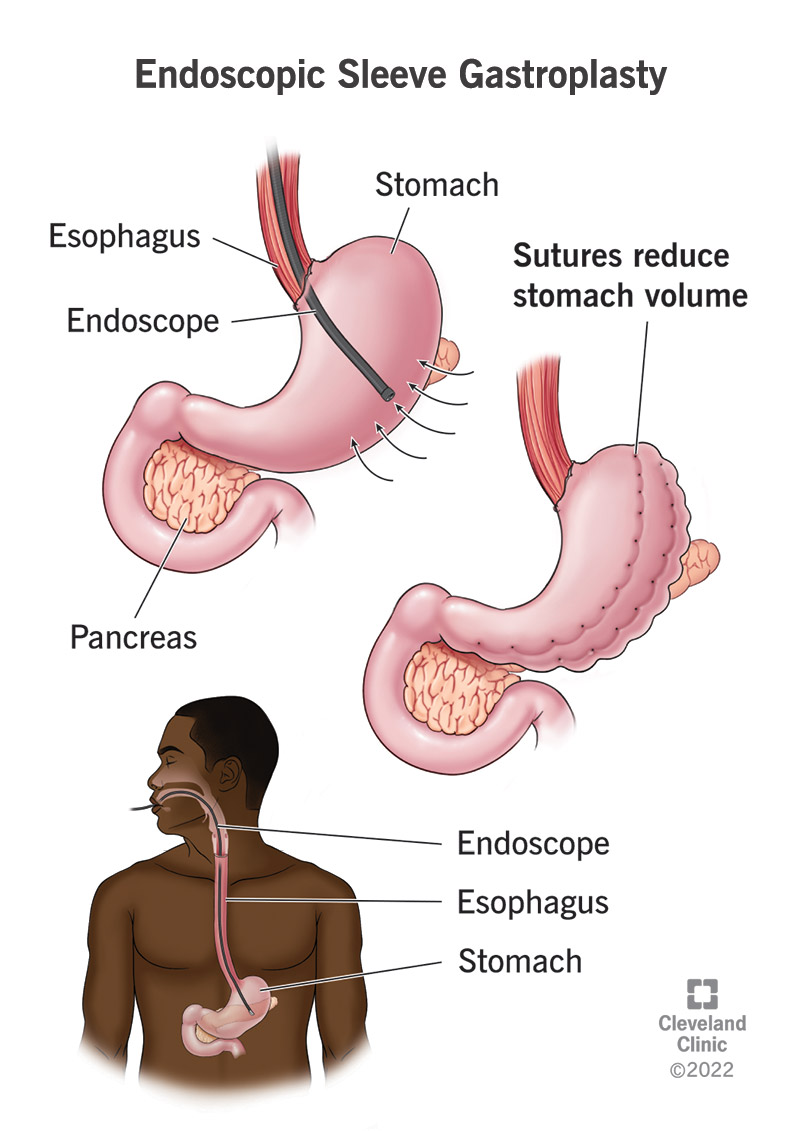Endoscopic sleeve gastroplasty is a weight loss procedure. Surgeons use an endoscope to put stitches in your stomach. There’s no cutting or scarring. The procedure makes your stomach smaller and more tubelike.
Advertisement
Cleveland Clinic is a non-profit academic medical center. Advertising on our site helps support our mission. We do not endorse non-Cleveland Clinic products or services. Policy

Endoscopic sleeve gastroplasty (ESG) is a weight loss procedure that reduces the size of your stomach. It’s a treatment for children and adults with obesity (typically a BMI of 30 or higher). ESG is a minimally invasive alternative to sleeve gastrectomy surgery and other bariatric surgery procedures.
Advertisement
Cleveland Clinic is a non-profit academic medical center. Advertising on our site helps support our mission. We do not endorse non-Cleveland Clinic products or services. Policy
ESG lets your surgeon change your stomach without making any cuts into your belly. They do this by sliding an endoscope (a long, thin tube with a small camera) down your throat and into your stomach. They use stitches to close off a portion of your stomach. This reduces your stomach to a tubelike sleeve, which is about 30% of its original size. The smaller size limits how much you can eat. The narrow shape makes it take longer for your stomach to empty, so you feel fuller longer.
It may be an option for you if weight loss methods like exercise and changes to your diet were unsuccessful. Your healthcare provider can let you know if ESG could work well to help you lose weight.
Here is what you can expect:
Advertisement
The procedure itself takes 60 to 90 minutes. You may be able to go home later that day, but most people stay overnight so they can be monitored.
Most people have mild pain as their stomach heals. Some have more pronounced pain and nausea for a few days afterward. These side effects are often manageable with over-the-counter (OTC) medications.
Benefits include:
Risks include:
Side effects from the procedure often go away within the first week. Most people can return to work at this time. It takes about a month before your stomach is healed enough to eat normally. You’ll have to eat carefully during this time. You’ll start on a liquid diet, then move to a soft diet. Finally, you’ll eat solid foods.
Most people lose 15% to 20% of their total weight within the first year. Weight regain is possible. But eating nutritious foods and exercising regularly can help you maintain your results.
Call your healthcare provider if you have any of the following after ESG:
It can be very hard to lose weight. Obesity isn’t an easy condition to navigate. Often, changes to your diet and exercise aren’t enough. Weight loss surgery can help many people lose weight, but not everyone qualifies and it carries risks.
But now, endoscopic sleeve gastroplasty is becoming a new choice. Procedures like ESG give weight-loss results, without major surgery. Ask your healthcare team is ESG is an option for you. They can talk to you about the risks and benefits of the procedure.
Advertisement
If you have obesity and losing weight is an uphill battle, Cleveland Clinic experts can help you decide if bariatric surgery is an option.

Last reviewed on 12/03/2025.
Learn more about the Health Library and our editorial process.